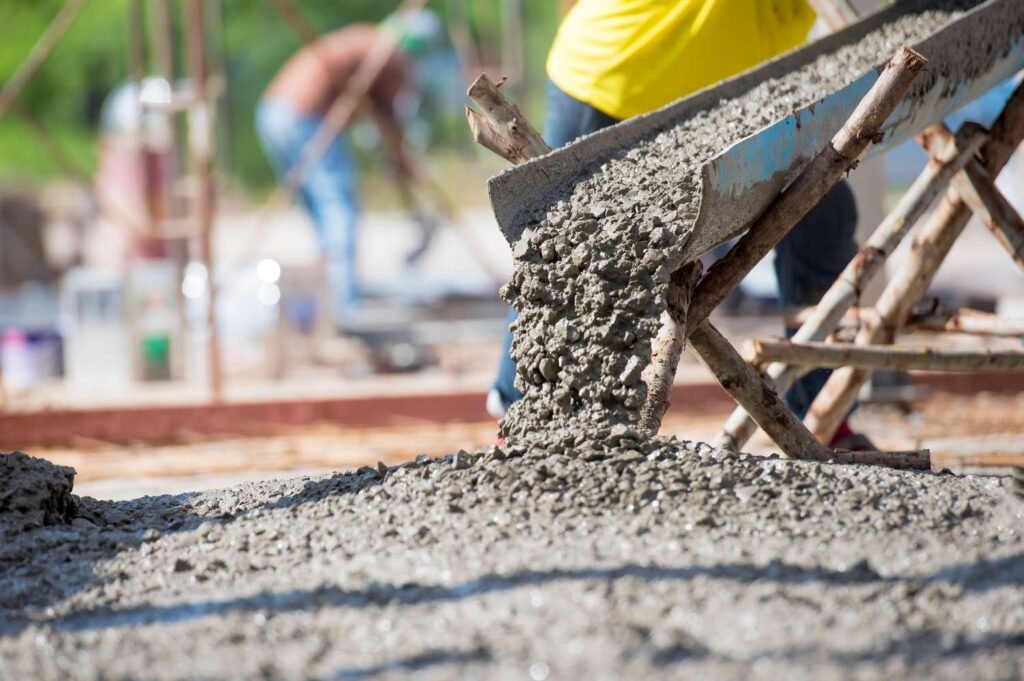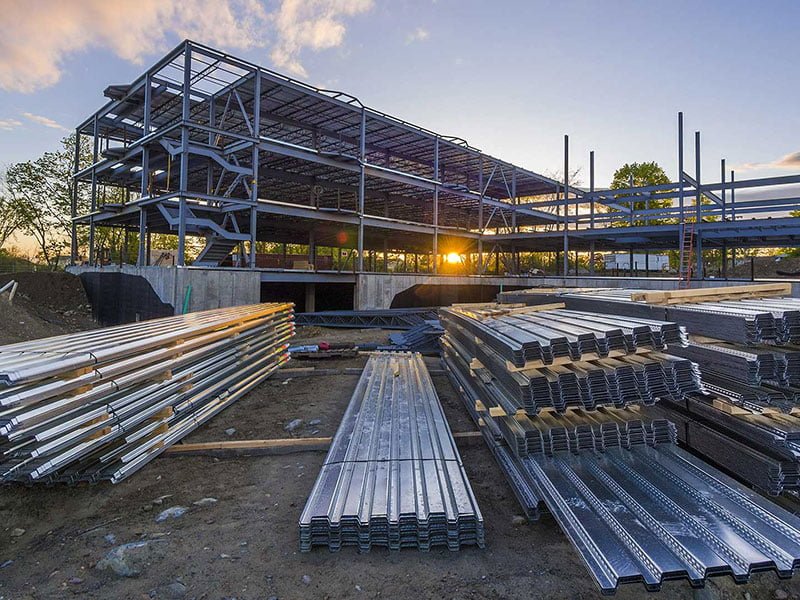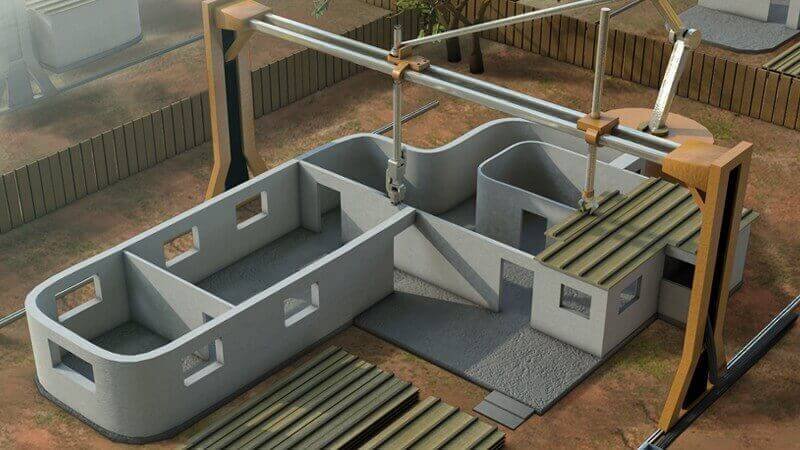Understanding The Different Types Of Materials Used in Construction

Table of Contents
Materials used in construction are essential components in the building process, contributing to the strength, durability, and functionality of structures. The selection of building materials depends on various factors, such as the intended use of the building, the budget, and the environmental conditions of the location. The materials used in construction can range from natural materials like wood, stone, and clay to synthetic materials like concrete, steel, and plastics. As a well-accomplished and experienced construction company based in Jaipur, let us introduce you to some of the most common materials used in construction.
Common Materials Used in Construction
Construction materials are the materials used to construct different types of buildings, roads, and other infrastructure. The choice of construction materials is based on their cost-effectiveness, availability, durability, and environmental impact. Here are some of the most common materials used in construction:
1. Wood & Timber

Wood and timber are the most common materials used in construction. They are used for various purposes, such as framing, flooring, roofing, and cladding. Wood is a renewable resource, and it has a low carbon footprint. However, it is susceptible to rotting, insects, and fire, and it requires regular maintenance.
2. Concrete

Concrete is a versatile material used in construction for foundations, walls, floors, and roofs. It is made by mixing cement, water, and aggregates, such as sand and gravel. Concrete is durable, fire-resistant, and has good thermal mass. However, it has a high carbon footprint, and its production requires a lot of energy.
3. Cement

Cement is the binding agent used in concrete and mortar. It is made by heating limestone and clay in a kiln and grinding the resulting clinker into a fine powder. Cement is used in construction for its binding properties, and it can be used as a standalone material for masonry and plastering. To learn more about cement and its different uses in construction, check this out.
4. Metals

Metals, such as steel, aluminum, and copper, are used in construction for their strength, durability, and corrosion resistance. They are used for structural elements, such as beams, columns, and trusses, as well as for roofing, cladding, and electrical wiring. Metals have a high embodied energy and a significant carbon footprint, but they are recyclable.
5. Glass

Glass is a transparent material used in construction for windows, doors, and facades. It allows natural light to enter buildings, and it provides thermal insulation and soundproofing. Glass can be tempered, laminated, or coated for safety, security, and energy efficiency. However, glass is fragile, and it can break or shatter under impact. To ensure the safety and security of everyone inside and outside of the building, we feel that it is our duty to ensure that we use only the top quality construction materials and that’s why we collaborate with brands that deliver exactly that. Check out our list of associates to better understand how we ensure that we maintain the highest standards of quality at the time of construction.
6. Stones
Stones, such as granite, limestone, and marble, are natural materials used in construction for their durability, strength, and aesthetics. They are used for foundations, walls, flooring, and decorative elements. Stones are resistant to fire, weather, and pests, and they require little maintenance. However, stones are heavy, expensive, and difficult to shape and transport.
7. Bricks

Bricks are clay-based materials used in construction for their strength, durability, and fire resistance. They are used for walls, chimneys, and fireplaces. Bricks can be molded into various shapes and sizes, and they can be glazed or painted for decoration. However, bricks have a high embodied energy, and their production requires a lot of water and fuel.
8. Plastics

Plastics, such as PVC, polyethylene, and polycarbonate, are synthetic materials used in construction for their versatility, durability, and low cost. They are used for piping, insulation, roofing, and cladding. Plastics can be molded, extruded, or laminated into various forms and colors. However, plastics are non-biodegradable, and they can release toxic fumes when burned.
9. Composites
Composites are materials made by combining two or more materials to achieve specific properties, such as strength, stiffness, and lightness. They are used in construction for structural elements, such as bridges, decks, and facades. Composites can be made from fibers, such as carbon, glass, or aramid, and resins, such as epoxy or polyester. However, composites are expensive, and their production requires specialized equipment and skills. The role of composites and its benefits have been debriefed here.
Historical Context of Materials Used In Construction

Throughout history, humans have used a variety of materials to construct buildings, bridges, and other structures. The materials used in construction have evolved over time, as new technologies and materials have been developed and as social and economic factors have influenced building practices.
In ancient times, people used materials that were readily available in their local environments. For example, in areas with abundant trees, wood was a common building material. In regions with plentiful stone, buildings were often constructed of stone blocks. mud, straw, and other natural materials were also used in construction.
As societies developed and became more complex, new materials were introduced. For example, the introduction of fired brick in the middle ages allowed for the construction of more durable and complex structures. The use of concrete, which was developed by the ancient Romans, became more widespread during the Renaissance.
During the Industrial Revolution, new materials such as steel and glass became available, leading to the construction of skyscrapers and other large-scale structures. Today, a wide variety of materials are used in construction, including concrete, steel, wood, glass, and plastics.
The choice of materials used in construction is influenced by a variety of factors, including availability, cost, durability, and aesthetics. In some cases, environmental concerns may also play a role in material selection. For example, the use of sustainable materials such as bamboo and recycled materials is becoming more common in modern construction.
In summary, the historical context of materials used in construction reflects the evolution of human society and technology. From simple natural materials to complex modern composites, the materials used in construction have shaped the built environment and will continue to do so in the future. Check out our projects to see how we utilize modern age construction materials to bring buildings to life.
Classification of Building Materials

Building materials can be classified into two main categories: natural materials and synthetic materials. Natural materials are derived from nature and include materials such as wood, stone, clay, and sand. Synthetic materials, on the other hand, are man-made and include materials such as plastics, metals, and composites.
1. Natural Materials
Natural materials have been used in construction for thousands of years and are still widely used today. They are valued for their durability, sustainability, and aesthetic appeal. Some common natural building materials include:
- Wood: Used for framing, flooring, and finishing. It is renewable, biodegradable, and has good insulation properties.
- Stone: Used for walls, floors, and landscaping. It is durable, fire-resistant, and has a natural beauty.
- Clay: Used for bricks, tiles, and pottery. It is abundant, inexpensive, and has good insulation properties.
- Sand: Used for concrete, mortar, and glass. It is abundant and easily accessible.
2. Synthetic Materials
Synthetic materials have become increasingly popular in construction due to their versatility, strength, and durability. They are often used in combination with natural materials to create modern, efficient structures. Some common synthetic building materials include:
- Plastics: Used for insulation, roofing, and piping. They are lightweight, durable, and resistant to corrosion.
- Metals: Used for structural elements, roofing, and facades. They are strong, durable, and can be recycled.
- Composites: Used for decking, cladding, and structural elements. They are lightweight, strong, and can be designed to mimic natural materials.
In conclusion, the classification of building materials is an important aspect of construction. Understanding the properties and characteristics of different materials can help builders make informed decisions about which materials to use for different applications. Whether natural or synthetic, each material has its own unique advantages and disadvantages that must be considered.
Properties of Construction Materials
Construction materials have a variety of properties that make them suitable for different applications. These properties can be categorized into three main types: physical, chemical, and mechanical properties.
1. Physical Properties
Physical properties of construction materials include density, porosity, thermal conductivity, and electrical conductivity. Density is the mass per unit volume of a material, and it determines the weight of the material. Porosity is the ratio of the volume of voids to the total volume of the material, and it affects the strength and durability of the material. Thermal conductivity is the ability of a material to conduct heat, and it determines how well a material can insulate. Electrical conductivity is the ability of a material to conduct electricity, and it determines how well a material can conduct electrical current.
2. Chemical Properties
Chemical properties of construction materials include chemical composition, reactivity, and corrosion resistance. The chemical composition determines the properties of the material, such as its strength, durability, and resistance to corrosion. Reactivity is the ability of a material to react with other substances, and it determines the material’s suitability for different applications. Corrosion resistance is the ability of a material to resist corrosion, and it determines the material’s suitability for use in environments with high levels of moisture or exposure to chemicals. Here is a link to a list of corrosion-resistant materials used in construction.
3. Mechanical Properties
Mechanical properties of construction materials include strength, elasticity, and ductility. Strength is the ability of a material to resist deformation, and it determines the material’s ability to withstand loads. Elasticity is the ability of a material to deform and then return to its original shape, and it determines the material’s ability to absorb energy. Ductility is the ability of a material to deform without breaking, and it determines the material’s ability to undergo plastic deformation.
In summary, the physical, chemical, and mechanical properties of construction materials are important factors in determining their suitability for different applications. Understanding these properties can help builders and engineers select the right materials for their projects, ensuring that they are safe, durable, and cost-effective.
Sustainability in Construction Materials
1. Ecofriendly Materials

Sustainable construction materials are those that have a low environmental impact and can be used repeatedly without losing their quality. Eco-friendly materials are becoming increasingly popular in construction as people become more aware of the impact of their actions on the environment. These materials are made from renewable resources and are biodegradable, reducing the amount of waste that ends up in landfills.
One example of an eco-friendly material is bamboo. Bamboo is a fast-growing plant that requires less water and fertilizer than other crops. It is also strong and durable, making it an excellent building material. Other eco-friendly materials include clay, straw, and hempcrete. Here is an extended list of eco-friendly materials.
2. Recycling & Reuse
Another way to promote sustainability in construction is to recycle and reuse materials. This reduces the amount of waste that ends up in landfills and conserves natural resources. Recycled materials can be used in a variety of ways, such as in road construction, building foundations, and insulation.
Recycling and reuse can also save money. For example, using recycled steel instead of new steel can save up to 75% of the energy that would be required to produce new steel. Recycled concrete can also be used in construction, reducing the need for new concrete and the associated carbon emissions.
In conclusion, sustainability in construction materials is becoming increasingly important as people become more aware of the impact of their actions on the environment. Eco-friendly materials and recycling and reuse are two ways to promote sustainability in construction. By using sustainable materials and practices, we can reduce our impact on the environment and create a more sustainable future.
Innovations in Construction Materials
1. Smart Materials
Smart materials are a new class of materials that have the ability to change their properties in response to external stimuli such as temperature, light, or pressure. These materials have been used in construction to create self-healing concrete, which has the ability to repair cracks automatically. The self-healing concrete contains capsules of a healing agent that is released when a crack appears, filling the crack and restoring the integrity of the concrete.
Another application of smart materials in construction is the use of shape memory alloys (SMAs) in building components. SMAs are metals that can remember their original shape and return to it when heated. This property has been used in the construction of buildings with movable components such as windows, doors, and roofs. The SMAs allow these components to change shape without the need for motors or other mechanical components.
2. Nanomaterials

Nanomaterials are materials that are engineered at the nanoscale, which is approximately 1 to 100 nanometers in size. These materials have unique properties such as high strength, high conductivity, and increased surface area, which make them ideal for use in construction.
One application of nanomaterials in construction is the use of nanoclay in concrete. Nanoclay is a type of clay that has been engineered at the nanoscale, which makes it highly effective at improving the strength and durability of concrete. Nanoclay can also be used to reduce the amount of cement needed in concrete, which can help to reduce the carbon footprint of construction.
Another application of nanomaterials in construction is the use of graphene in building components. Graphene is a highly conductive material that is 200 times stronger than steel. Graphene can be used to create lightweight, high-strength building components such as beams, columns, and cables. You can learn more about Nano clays here.
Future Trends in Construction Materials
1. Biodegradable Materials
The use of biodegradable materials in construction is a growing trend, driven by the need for sustainable building practices. Biodegradable materials are those that can be broken down by natural processes, such as microorganisms, into harmless substances. These materials can be used in a variety of construction applications, including insulation, roofing, and flooring.
One example of a biodegradable material is mycelium, which is the vegetative part of a fungus. Mycelium can be grown into a durable material that can be used as a substitute for traditional building materials. Other biodegradable materials include bamboo, straw, and hempcrete, which is a mixture of hemp and lime.
2. 3-D Printing Materials

3D printing is a rapidly growing technology that has the potential to revolutionize the construction industry. It allows for the creation of complex shapes and designs that would be difficult or impossible to achieve with traditional construction methods. 3D printing can also reduce waste and construction time, as well as lower costs.
One material that is being used in 3D printing is concrete. 3D-printed concrete structures have been successfully built in recent years, including a pedestrian bridge in the Netherlands and a house in Russia. Other materials that can be used in 3D printing include plastics, metals, and ceramics.
In conclusion, the use of biodegradable materials and 3D printing materials are two future trends in construction that are gaining popularity. These materials offer sustainable and innovative solutions for building structures that are both durable and eco-friendly.







